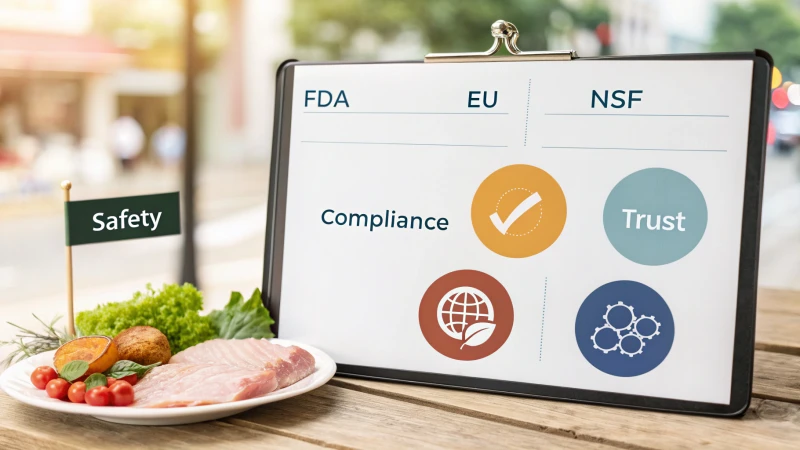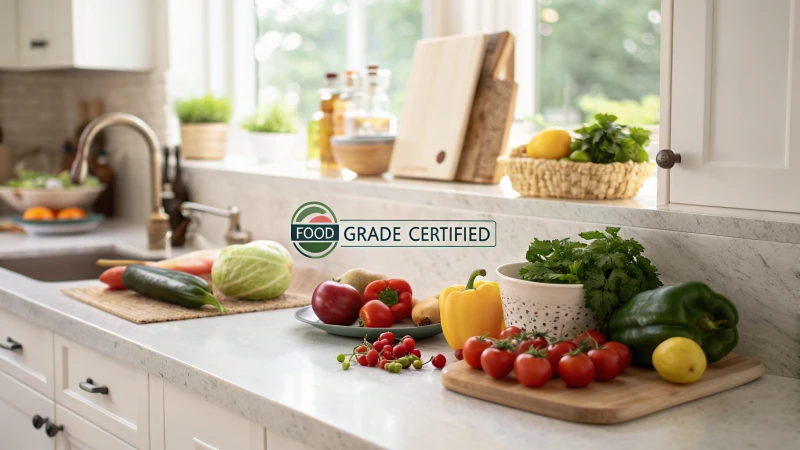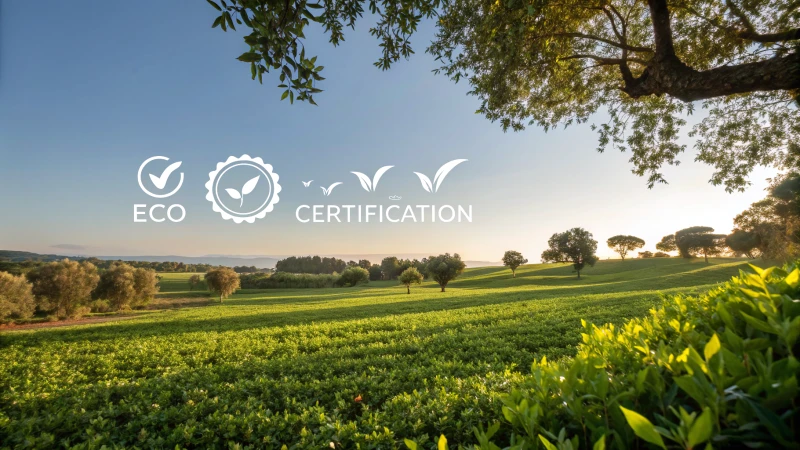
Imagine a world where dining sustainably is both stylish and safe.
Food-grade certification assures that disposable wooden cutlery adheres to strict safety standards for food contact, protecting consumer health while bolstering product credibility. This certification is essential for businesses aiming to comply with health regulations and offer a reliable dining experience.
Understanding the ins and outs of food-grade certification not only guides you in choosing the right products but also plays a pivotal role in establishing a sustainable brand image. Let's explore why this certification is so important and how it can affect your business's reputation and adherence to regulations.
Food-grade certification is mandatory for all wooden cutlery.False
Not all jurisdictions require mandatory food-grade certification.
Certification enhances the credibility of wooden cutlery products.True
Certification assures consumers of safety and compliance, boosting trust.
What Are the Key Standards for Food-Grade Certification?
Ever wonder how a simple spoon gets its food-grade certification? It's not just about safety; it's about trust, quality, and ensuring every bite is as good as the last.
Key standards for food-grade certification include FDA guidelines, EU regulations, and NSF International standards. These ensure that products are safe for direct contact with food, preventing contamination and ensuring consumer safety.

Understanding Key Food-Grade Standards
When I first delved into the world of food-grade certification, it felt like unraveling a mystery. How do we ensure that a fork is safe enough for our kids to use at school lunches or that our morning coffee cup won't leach harmful chemicals? It turns out, several key standards must be adhered to, protecting consumers and enhancing trust1 in the marketplace.
FDA Guidelines
I remember my first encounter with the U.S. Food and Drug Administration (FDA) guidelines. It was during a project aimed at launching a line of eco-friendly utensils. The FDA's comprehensive guidelines were like a roadmap, ensuring that our materials wouldn’t introduce unwanted chemicals into our food. CFR Title 21 became my best friend during that time, outlining all the specifics for food contact substances.
European Union (EU) Regulations
The European Union takes things up a notch with its rigorous standards. I recall a colleague sharing stories from their time working on compliance projects in Europe. They emphasized how Regulation (EC) No 1935/2004 was crucial in ensuring that materials not only kept our food safe but also preserved its natural taste and quality.
| Regulation | Description |
|---|---|
| EC No 1935/2004 | General requirements for all food contact materials |
| EU 10/2011 | Specific requirements for plastic materials |
NSF International Standards
Then there’s NSF International, offering certifications that cover not just safety but also quality and performance. I once visited a factory where the NSF standards were the backbone of their operations. Watching how they tested their products to withstand rigorous cleaning processes without compromising safety was truly inspiring.
How These Standards Impact Industries
In the food and beverage industry, compliance isn’t just a checkbox; it’s a commitment to safety and trust. Restaurants, for instance, can’t afford to cut corners when it comes to certified utensils. And in healthcare, those wooden tongue depressors must meet strict standards to ensure they’re safe for patient use.
For any business in manufacturing or distributing food-contact products, staying informed about these certifications isn’t optional—it’s essential. Not only does it protect public health, but it also bolsters brand reputation in eco-conscious markets2. By using certified materials, businesses can rest assured they're supporting both consumer safety and their brand's integrity.
FDA guidelines prevent harmful chemical release into food.True
FDA regulations ensure materials do not release harmful chemicals.
EU 10/2011 applies to all food contact materials.False
EU 10/2011 specifically targets plastic materials.
Why Is Food-Grade Certification Essential for Consumer Trust?
Ever wondered how the simple act of certifying food-grade products can transform a brand's relationship with its customers?
Food-grade certification is essential because it ensures that products are safe for food contact, fostering consumer trust. It verifies compliance with health standards, reduces contamination risks, and enhances product appeal, ultimately building confidence among buyers.

Understanding Food-Grade Certification
I remember when I first dove into the world of food-grade certification; it felt like learning a new language. This certification isn't just a stamp—it's a thorough process that ensures materials are safe for contact with food. For companies making wooden cutlery3, this is crucial. It's like having a protective shield against contamination.
The Role of Certification in Consumer Trust
Nowadays, people, including myself, are more aware and cautious about what they buy. They want to be sure that products meet specific safety standards. Food-grade certifications are like a badge of honor, showing that products have passed rigorous tests and comply with health guidelines.
Enhancing Market Appeal
Whenever I shop, I notice myself gravitating toward certified products. There's something reassuring about knowing they’ve been vetted for safety. This is especially true for eco-conscious buyers4, who often seek certified items to align with their sustainable lifestyle.
Certification Standards and Guidelines
Navigating the various certification standards across countries can feel like piecing together a global puzzle. The U.S.'s FDA and Europe's EFSA have their own sets of rules. Meeting these standards is key for any manufacturer looking to expand into new markets.
| Country | Regulatory Body | Certification Standard |
|---|---|---|
| USA | FDA | FDA CFR 21 |
| EU | EFSA | EU Regulation 1935/2004 |
The Impact on Business Partnerships
For businesses like WonBon5, embracing food-grade certification isn't just about ticking a box; it's about opening doors to partnerships with eco-friendly companies. It signals a commitment to quality and makes them a sought-after supplier.
In wrapping up, while food-grade certification starts with compliance, its true strength lies in forging and maintaining consumer trust. Certified products not only adhere to legal requirements but also resonate with consumer values, enhancing brand reputation and marketability.
Challenges in Certification
Securing food-grade certification can feel like climbing a mountain. It involves wading through complex regulations and investing in detailed testing processes. But as challenging as it might be, the long-term rewards—like increased trust and market access—make it worthwhile.
Food-grade certification is mandatory worldwide.False
Certification requirements vary by country; it's not universally mandatory.
Certified products are perceived as safer by consumers.True
Consumers often trust certified products more due to safety assurance.
How Does Certification Impact Environmental Sustainability?
Remember that time you made a conscious decision to buy eco-friendly products, only to find out later they weren't as green as promised?
Certification impacts environmental sustainability by enforcing eco-friendly standards, promoting transparency, and encouraging sustainable practices. It helps businesses align with global environmental goals, thereby reducing ecological footprints.

The Role of Certifications in Environmental Sustainability
I’ve always believed that actions speak louder than words, especially when it comes to sustainability. Certifications act as the stamp of approval that companies need to prove they are walking the talk. Think of it like a badge of honor; not only does it polish a company’s reputation, but it also assures us, the consumers, that what we’re buying is truly eco-friendly.
Popular Environmental Certifications
Navigating the world of certifications can feel like learning a new language. Each one has its own focus, like the Forest Stewardship Council6, which is all about responsible forest management. Then there's ISO 14001, which I liken to a personal trainer for companies, helping them improve their environmental management systems.
| Certification | Focus Area | Benefits |
|---|---|---|
| FSC | Sustainable Forestry | Promotes biodiversity |
| ISO 14001 | Environmental Management Systems | Enhances operational efficiency |
| LEED | Green Building | Reduces energy consumption |
Encouraging Corporate Responsibility
When companies go for these certifications, it’s like they’re pledging allegiance to sustainability. It encourages them to adopt greener methods and cut down on waste. I've seen firsthand how this commitment can boost a company’s standing in the market—after all, who wouldn’t want to support a business that’s doing good? For instance, corporations with LEED certifications7 often enjoy lower operating costs and increased asset value. This sets a trend that others eagerly follow, creating a ripple effect of sustainability across industries.
Challenges and Considerations
However, let’s be real—obtaining these certifications isn’t always a walk in the park. It can require a significant investment of time and money. But from what I’ve observed, the long-term benefits often outweigh the initial hurdles. As more consumers demand sustainable products, businesses that step up their certification game tend to stand out in the marketplace. So yes, while it might seem daunting at first, getting certified can be a powerful move towards achieving global sustainability goals.
Certifications ensure companies meet environmental standards.True
Certifications verify adherence to specific environmental criteria, promoting sustainability.
LEED certification increases energy consumption in buildings.False
LEED certification aims to reduce energy consumption through sustainable building practices.
What Should Businesses Look for in Certified Wooden Cutlery?
I remember my first eco-conscious purchase for my business: wooden cutlery. I was clueless about certifications, but I quickly learned they mattered more than I realized.
Businesses should prioritize wooden cutlery with FSC or PEFC food-grade certifications to ensure sustainability and safety. These certifications not only guarantee responsible sourcing and compliance with health standards but also foster consumer trust.

Understanding Key Certifications
Choosing the right wooden cutlery starts with understanding the importance of certifications. When I first started sourcing eco-friendly products, I didn't know much about the FSC (Forest Stewardship Council) and PEFC (Programme for the Endorsement of Forest Certification). But learning that these certifications ensure sustainable forestry and traceability was a game-changer for my business decisions.
| Certification | Purpose |
|---|---|
| FSC | Ensures sustainable forestry practices |
| PEFC | Guarantees wood traceability |
These certifications aren't just bureaucratic hoops; they mean your product meets tough environmental and social standards, which can significantly boost consumer confidence.
Importance of Food-Grade Certification
Working in the food service industry taught me that ensuring our wooden cutlery is food-grade certified is crucial. This certification isn’t just a checkbox; it’s a promise of safety for our customers when they use our products to enjoy their meals.
Health and Safety Standards
- Safety Tests: Ensuring products are free from toxins and allergens has been pivotal in maintaining our brand's reputation.
- Compliance: We always check compliance with EU regulations8 and FDA standards9 to meet international safety benchmarks.
These standards reassure our customers that they’re in safe hands, fostering trust and loyalty.
Assessing Aesthetic and Functionality
Aesthetics can’t be overlooked. Wooden cutlery should be both safe and visually appealing to enhance our brand image. From my experience, investing in:
- Design Customization: Adding our logo elevated our brand presence.
- Durability: Ensuring strength akin to traditional cutlery reduced breakages.
- Finish Quality: A smooth finish improved user experience immensely.
Design customizations10 have been a fantastic way to make a memorable impact while keeping our eco-friendly promise.
Evaluating Supplier Reliability
I learned the hard way that reliable suppliers are key to maintaining quality and supply. Now, I always consider suppliers who:
- Have a history of meeting deadlines.
- Offer competitive pricing without skimping on quality.
- Maintain transparent practices and excellent customer service.
By choosing suppliers who share our sustainability goals11, we ensure our supply chain remains robust and aligned with our green initiatives.
By focusing on these aspects, businesses can confidently select wooden cutlery that meets environmental standards while fulfilling consumer demands for sustainable, safe, and stylish dining solutions.
Conclusion Considerations
While this guide highlights what to look for, remember to stay updated on market trends and evolving standards. Continuous assessment ensures your offerings remain aligned with sustainability and consumer expectations. Every decision counts in shaping a responsible purchasing strategy.
Stay informed, stay responsible, and choose wisely! More insights12 on sustainable practices await your exploration.
FSC certification ensures sustainable forestry practices.True
FSC certifies that wood is sourced from responsibly managed forests.
Wooden cutlery with PEFC certification is not traceable.False
PEFC certification verifies the traceability of the wood's origin.
Conclusion
Food-grade certification for disposable wooden cutlery ensures safety, compliance with health standards, and enhances consumer trust, making it essential for sustainable dining experiences.
-
Understanding how certifications build trust can help businesses enhance their reputation and consumer confidence. ↩
-
Learning about eco-certifications can highlight market advantages and brand growth opportunities. ↩
-
Discover why food-grade certification is crucial for ensuring the safety of wooden cutlery in food contact applications. ↩
-
Explore how the preferences of eco-conscious consumers drive demand for certified products. ↩
-
Learn about WonBon's dedication to providing eco-friendly solutions through certified products. ↩
-
Explore how FSC certification ensures responsible forest management, supporting biodiversity and sustainable forestry practices. ↩
-
Learn how LEED certification leads to lower operating costs and increased asset value, driving corporate sustainability. ↩
-
Explore comprehensive EU regulations ensuring food safety compliance for materials in contact with food. ↩
-
Discover FDA guidelines ensuring safety in wooden cutlery used in food services. ↩
-
Learn about customization possibilities to enhance brand identity through unique design features. ↩
-
Understand how sustainable partnerships contribute to long-term business success. ↩
-
Stay updated on innovative trends reshaping sustainable dining experiences. ↩

